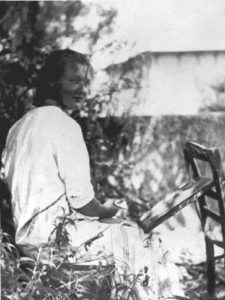
“It has always been easier for women to enter museums in the nude than clothed and wielding a paintbrush.”
The miracle was she survived.
The aunt she was named after died by her own hand. So, she learned years later, did her mother. Her grandmother, great-grandmother, and a number of other relatives died by suicide. But she did not.
And this little girl who had been “not very gifted, not very pretty, not very energetic, rather indolent, lacking in self-control, and egoistic” became one of the greatest artists of the 20th century, with a bold and energetic independence of spirit and style. In unimaginable circumstances, the German Jewish Charlotte Salomon fought the suicidal impulses of generations, responding to “the question: whether to take her own life or undertake something wildly unusual.” She opted for the latter, creating Life? or Theater?, a somewhat fictional, largely autobiographical operatic series of gouaches combining text and images and, by the extension of imagination, music, too.
So she lived until 26, when, as a newlywed several months pregnant, she was taken by the Nazis and gassed at Auschwitz in 1943. Rather than die by her own hand, she was killed at the hands of others. Her tragic biography is also a story of existential triumph.
In some sense, she created the first “graphic novel” – in blues, yellows, and reds, wielded with a fierce exuberance. As novelist Jonathan Safran Foer wrote: “Beautiful things are contagious, and no work of art has inspired me to strive to make art more than Life? or Theater? has. No work is better at reminding me what is worth striving for. The images … are simply my antidotes to indifference.”
An excerpt from Lisa Appignanesi‘s “Painting on the Precipice” in a recent issue of the New York of Books traces how we got to know her work at all:

Kristallnacht
It may have been the Salomons’ acquaintance in Amsterdam with Anne Frank’s father, Otto Frank, that encouraged them to make Charlotte’s work public. The process took time. It was inevitably mired in the family’s grief and desire to forget, a now recognized unwillingness or inability of survivors to share painful matters. The first Salomon exhibition was held in 1961 at the Fodor branch of the Stedelijk Museum. A catalog entry written by Charlotte’s father calls her book “an analytical diary written from memory.” The word “diary,” combined with the book’s association with the Holocaust, led to a shallow analogy between Anne Frank’s moving chronicle of daily life in hiding and Charlotte Salomon’s radical and tormented pictorial examination of her own life and that of Berlin’s Jews from World War I through the rise of Nazism.
Another factor that may have suppressed Salomon’s reputation is the general modernist distaste for art embedded in story, even though in past centuries so much art used to be. Artists such as Paula Rego and Kara Walker have gradually altered our ways of seeing. But the trouble with Salomon’s Life? or Theatre? is that it can’t be divided and sold as individual pieces in the gallery world so effective at creating value.

She speculates that current interest may be fueled by the rise of the graphic novel. “Then, too, after Jean-Michel Basquiat we’ve grown accustomed to bursts of text on image. But it may also be that the very conditions of Salomon’s life have swallowed her work up into the greater story of the Holocaust—ever anxious about the possibilities of its own representation.”
The reason for my own interest tonight is that I was leafing through the excellent new Taschen volume, lavishly presenting and reproducing 450 of Salomon’s most important pieces – according to the publisher, “an unrivalled magnum opus from a great and ambitious artist, overshadowed by her early death, but luminous with her precision, her lyricism, and her courage.”
She famously put entrusted the magnum opus to the keeping of a friend, with the instructions, “Take good care of it. It is my life.” It is a life, though light years beyond autobiography – and somehow it even makes the term Gesamtkunstwerk, a Wagnerian “total work of art,” sound chilly and merely aesthetic. It is also a powerful reminder, should we need one, that a life looks very different driving forward than it does in the rearview mirror.
Tags: Charlotte Salomon, Jean-Michel Basquiat, Jonathan Safran Foer, Lisa Appignanesi

